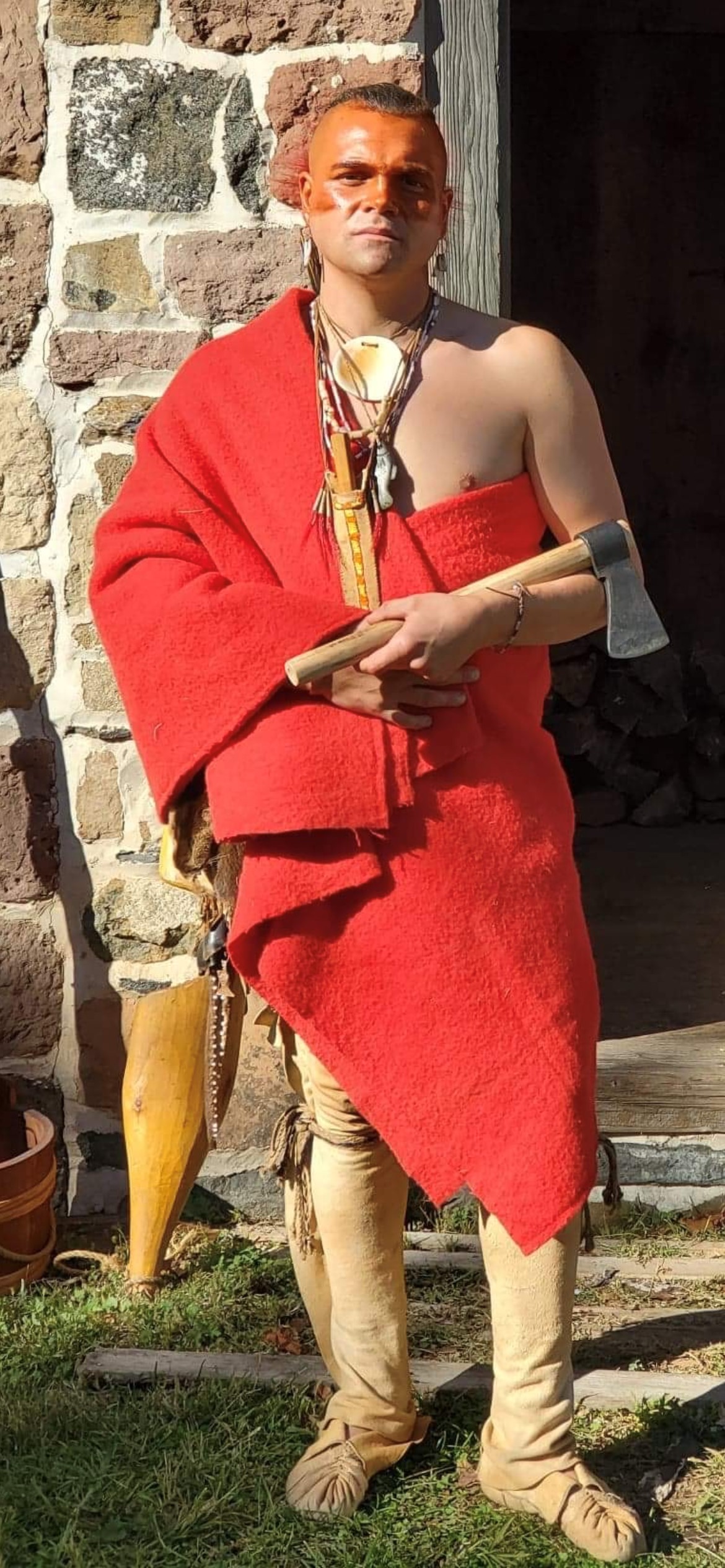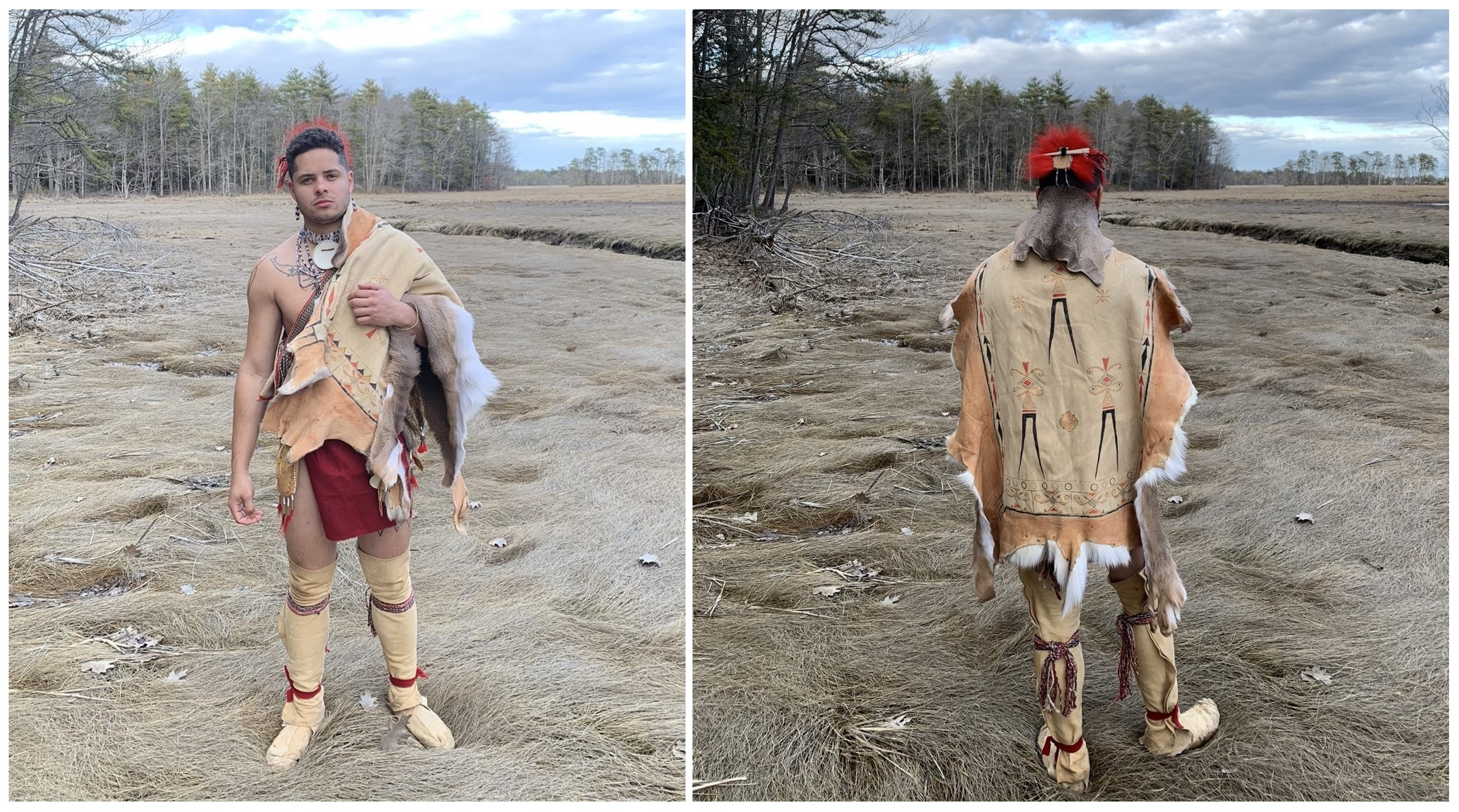
An Algonkian man of southern New Netherlands circa 1645-1660, Modeled by Drew Shuptar- Rayvis , Cultural Ambassador of the Pocomoke Indian Nation and living historian of the 17th and 18th century
Mantles and outer clothing of the Algonkian people of southern New Netherlands
Among the Algonkian peoples of southern New Netherlands during the 17th century; dress was broken into two categories, male and female. Male dress comprised of a breech cloth (made of leather or a coarse, thick woolen cloth called duffel by the 1640’s) fitted leather leggings and
Moccasins. Female dress comprised of a leather or later woolen wrap skirt, fitted leather leggings and moccasins. Though these modes of dress would change and fluctuate with the seasons, they both shared one piece of outer clothing; the mantle. This mantle became known throughout eastern North America as the “Matchcoat”; an animal skin, woolen or a woven feather garment worn over the body to keep it warm and add color/design to a person's clothing as well as likely to denote status within one's community. The word “Matchcoat” is said to derive from the proto algonkian word “Magigode” (mah gee goeD) meaning a skin mantle or garment. In the Renape dialect of the algonkian language found in parts of the eastern shore of Maryland, Virginia and eastern Virginia the word is Matchkore meaning a leather mantle.
Matchcoats are recorded by Europeans as being several types. Some made of a deer skin or multiple skins sewn together whose fur side was worn on the body and the outer skin side of the mantle elaborately painted with designs. Others made of intricately woven turkey and duck feathers on a finger woven, natural fiber netting. These mantles are documented being worn in New England all the way to Virginia. Lastly, by the 1620’s. Europeans began arriving and brought with them one of the most valuable trading materials of the century; woolen cloth, in this case a material called Duffel. Duffel is a coarse woven and thick woolen cloth whose most documented colors being traded to native people were red and blue.
Duffel was a valuable trade item due to the fact that wool is water resistant, remains warm when wet, and is fire retardant, qualities that were of great importance for a people who lived and worked outdoors and by open fires. Besides the practicality of the material it was also in electric colors unobtainable to native people in their homelands, these colors possessed symbology for Algonkian people and made certain colors of red and blue more desirable.
Europeans as early as Verrazano’s voyage to what became eastern North America in 1524, record and note the mantles that are worn “Among them were two kings more beautiful in form and stature than can possibly be described; and they were dressed in the following manner; The oldest had a deer’s skin around his body, artificially wrought in damask figures [painted designs that were so elaborate they looked woven] his head was without covering, his hair was tied back in various knots [a 17th century term for braids]; around his neck he wore a large chain ornamented with many stones of different colors [likely wampum beads made of whelk and quahog clam shell]. The young man was similar in his general appearance”;
of the women “Their women are of the same form and beauty, very graceful, of fine countenances and pleasing appearance in manners and modesty; they wear no clothing except a deerskin, ornamented like those worn by the men; some wear very rich lynx skins upon their arms, and various ornaments upon their heads, composed of braids of hair, which also hang down upon their breasts on each side”(1)
Of the painted leather mantles made of deer and other furs (beaver and otter are mentioned in numerous documents) not much is known about them in great detail, however the painted designs which were so intricate and elaborate caught Europeans attention “The tribes are in the habit of clothing themselves with otter-skins, the fur inside, the smooth side without; which, however, they paint so beautifully that at a distance it resembles lace”(2)
Some of the other mantles mentioned by Europeans were mantles constructed from turkey feathers. The mantles also known as capes were made using the metallic iridescent breast feathers of turkeys and sometimes duck feathers. It would take hundreds of these chest feathers to make a mantle/cape that covered the body from the shoulders to the knees. These mantles would be constructed using a natural woven fiber netting that would weave and layer feathers in place creating the same overlapping effect that gives the birds their protection in the wild. Feather mantles like these certainly were not everyday wear and likely held high status or possibly ceremonial/fancy dress clothing. Feather mantles/capes like these were excellent at keeping the body insulated, warm and dry, thus mimicking the abilities the feathers have on the birds, as well as adding beautiful iridescent color to ones outfit. “Their clothing is almost naked. In winter time they usually wear a dressed deer skin; some have a bear’s skin about the body, some a coat of scales [possibly fish leather, however it is unknown as to what is being described], some a covering made of turkey feathers which they understand how to knit together very oddly, with small strings” (3)
By the middle 17th century, the duffel matchcoat worn by algonkian people in southern New Netherlands was also noted in documents. Duffel is a coarse woven woolen cloth that was one of the most prolific trade items in the northeast from 1620-1670. Also known as Dutch/ welsh rugged cloth and a similar cloth called “Frieze” was made in the Netherlands, England and France. Used in Europe for clothing such as coats and blankets, duffel became very popular as a piece of cloth cut into pieces the length of small blankets (roughly 54x72 inches). Duffel was important to Algonkian people for multiple reasons:
- It did not need to be made like a deer skin, bear skin or feather mantle/ cape and was already finished and ready to use
- duffel cloth came in multiple colors , the most common we find in documents being red and blue but in English records we also find mention of white, and purple.“the Indians clothing in former times was of the same matter as Adam’s was, viz. skins of beasts, as deer, moose, beaver, otters , raccoons, foxes, and other wild creatures. Also, some had mantles of the feathers of birds, quilled artificially; and sundry of them continue to this day their old kind of clothing. But for the most part they sell the skins and furs to the English, Dutch, and French, and buy of them for clothing a kind of cloth called duffels or trucking cloth, about a yard and a half wide, and for matter made of coarse wool. In that form as our ordinary bed blankets are made, only it is put into colors, as blue, red, purple, and some use them white. Of this sort of cloth two yards make a mantle for to coat for men and women, and less for children. This is all the garment they generally use”(4)
Dutch records also give us insight into the colors and buying preferences of algonkian and Iroquoian peoples of New Netherlands , in these records black and green are mentioned “The textiles that were shipped to New Netherland largely consisted of woolen cloth originating from Amsterdam, Leiden, and Kampen, Duffel, a coarse woolen cloth with a thick nap, was intended for the fur trade. The Indians used duffel in a way unfamiliar to the Europeans, one that surprised Isaack de Rasièr: “They also use a great deal of duffel cloth, which they buy from us, and which serves as their blanket by night and their dress by day.” He had found it was virtually impossible to sell red or green duffels, “because the wilden [Dutch colloquial term for Native Americans , slightly pejorative meaning wild man or wild people i.e. savages] say that it hinders them in hunting, as it is visible from too far off.” The Indians preferred black”(5)
Drew Shuptar-Rayvis
- Indian New England 1524-1674, Ronald Dale Karr, pgs 19-20 , paragraph 1- 3 , Giovanni De Verrazano (1524) pgs 14-22
- History of Westchester County New York, J. Thomas Scharf, 1886, quoted material from “Wassenares History of the New Netherlands” pg 13 paragraphs 3-4.
- The journal of Isaack de Rasieres to Samuel Blomaert 1626-1628, page 3 paragraph 1
- Indian New England 1524-1674, Ronald Dale Karr, pgs 50-51 paragraph 4-5 , Daniel Gookin (1674) pg 152
- The Colony of New Netherland , A Dutch Settlement in Seventeenth Century America , Jaap Jacobs , Cornell University Press, Pg 137, Paragraph 2 , section General Trade

An algonkian of southern New Netherlands in a painted deerskin mantle circa 1638-1650 , modeled by Dylan Smith, Algonkian living historian of the 17th and 18th century

